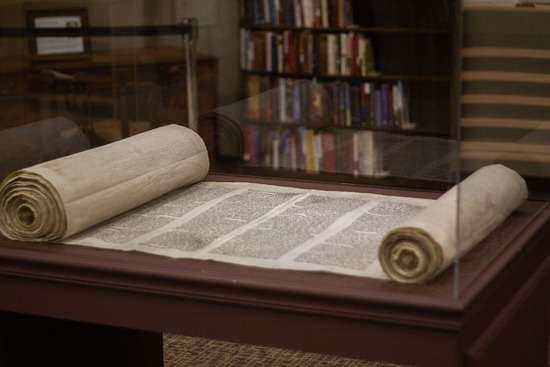Yes, you might be surprised to know that there are hundreds of verses in the Old Testament about Jesus.
While they don’t mention Jesus by name, they do mention other names we associate with Him like Messiah, Son of God, and Son of Man.
This is because Jesus and the plan of salvation are central themes of the Bible. Jesus Himself said the Scriptures (the Old Testament in His time) point toward Him and His ministry (John 5:39).
References to Him in the Old Testament can be divided into four categories, which we’ll explore on this page:
After we’ve looked at each one, we’ll also cover how you can notice Jesus in your personal study of the Old Testament.
Messianic prophecies
Messianic prophecies, prophecies predicting the life and identity of the Messiah, are some of the Bible’s most important verses. They show us that God had a plan to send a Savior from the beginning of time, and they help us to recognize Jesus’ role as the Messiah.
And the Bible doesn’t provide just one or two prophecies.
Theologians believe it contains more than 300 Messianic prophecies about Jesus.1
We’ll cover some of those prophecies below, including verses of their prediction in the Old Testament and fulfillment in the New Testament.
Jesus’ birth

Photo by Greyson Joralemon on Unsplash
The Old Testament prophesied the following key points about Jesus’ birth and lineage:
- The Savior would be born of a virgin (Isaiah 7:14; Matthew 1:23).
- He would come from the family line of Abraham, Isaac, and Jacob (Genesis 12:3; 19:19; 28:14; Luke 3:24).
- He would come from the line of David and thus have a direct claim to the throne (Isaiah 9:6-7; Acts 13:22-23).
- He would be born in Bethlehem (Micah 5:2; Matthew 2:4-6).
- He would be born among the Jewish people (Isaiah 9:6-7; Matthew 27:37).
Jesus’ life and ministry
- He would be called out of Egypt (Hosea 11:1; Matthew 2:14-15).
- He would be from Nazareth in Galilee (Isaiah 9:1-2; 11:1; Matthew 2:23; John 7:41).
- He would be preceded by a great messenger, John the Baptist (Isaiah 40:3-4; John 1:23).
- He would be called God’s Son (2 Samuel 7:14; Matthew 3:17).
- He would be a servant of God (Isaiah 53:11; Philippians 2:6-8; Matthew 10:45).
- He would perform miracles (Isaiah 35:5-6, Matthew 11:2-6).
- He would speak in parables (Psalm 78:1-2; Matthew 13:34-35).
- He would come into Jerusalem on a donkey (Zechariah 9:9-10; Matthew 21:1-11).
- He would minister to all nations—both Jews and Gentiles (Isaiah 11:10; John 12:18-21; Romans 1:16).
- He would be rejected as Messiah (Isaiah 53:3; Luke 4:28-29).
Jesus’ death and resurrection

Photo by Alicia Quan on Unsplash
- He would suffer and die for the sins of the world (Isaiah 19:20; 53:5, 12; John 1:12; Hebrews 9:28; 1 Peter 2:24).
- His victory would end the reign of Satan and sin (Genesis 3:15; 1 John 3:8).
- He would end the old covenant and start a new covenant (Jeremiah 31:31; Hebrews 9:15).
- He would be stripped of His clothing by Roman soldiers (Psalm 22:18; John 19:23-24).
- He would be beaten and mocked (Isaiah 50:6; Luke 22:63).
- He would be pierced in His hands and feet (Isaiah 53:3; Psalm 22:16; John 19:34).
- He would hang on a tree (Deuteronomy 21:22-23; Acts 5:30).
- He would be given vinegar to drink (Psalm 69:21; Matthew 27:34).
- He would resurrect from the dead (Psalm 118:17-18; Luke 24:5-7).
Each one of these verses was precisely fulfilled, giving us amazing evidence of Jesus’ role as the Messiah. They also show us that the Old Testament can teach us a lot about our New Testament Savior.
Christophanies

Photo by Brett Jordan on Unsplash
Christophanies refer to any time Jesus appears to humans. In the case of the Old Testament, we’re talking about any time He appears in the Bible prior to His human birth (called His pre-incarnate form).
Some of the most obvious examples are when the Godhead is mentioned or Jesus is “seen” in visions or miraculous events as the Son of God.
Here are a few examples:
Jesus at Creation with God
In Genesis 1:26, God said, “Let Us make man in Our image.” The use of plural words and the fact that only God can create suggests the presence of the Trinity—and thus the presence of God the Son, Jesus.
John 1:1-3 confirms this idea by telling us that the Word (Jesus, according to John 1:14) is God and created the world.
The Godhead at the Tower of Babel
In Genesis 11:6-7, God again uses plural words, saying, presumably to the Holy Spirit and God the Son, that they must put a stop to the building of the Tower of Babel.
The Son of Man coming to the throne in heaven
In Daniel 7:13-14, Daniel saw a vision of the Son of Man going to the throne of God and receiving the kingdom before coming to earth. The description sounds like the event that will happen right before Jesus’ second coming.
The Son of God in the fiery furnace
Although some Bible verses might refer to godly men by the term “sons of God” (Galatians 3:26-27), Jesus is the specific, singular Son of God.
In Daniel 3:35, Nebuchadnezzar recognizes a figure in the fiery furnace as a divine being. He calls the being the Son of God, suggesting Jesus’ presence in the fiery furnace.
The Son of God is also mentioned in Psalm 2:7, 11-12 and Proverbs 30:4.
Types

Photo by Pixabay
Types are Old Testament stories/characters/experiences that are reflected or fulfilled in the New Testament (the fulfillment is called an antitype). We see many of these similarities between characters of the Old Testament and Jesus.
Take a look at these examples:
Adam
The apostle Paul outright compares Jesus to Adam, calling Jesus the “second” Adam (1 Corinthians 15:45-49). Adam received dominion over the world but lost it when he sinned. On the other hand, Jesus regained dominion of the world by overcoming sin.
Abel
Like Jesus, Abel was faithful to God (Genesis 4:4). But because he was faithful, his brother killed him in a jealous rage (Genesis 4:5-8). Jesus was similarly killed by His own people who were jealous of His popularity (John 12:19) and angered at the way His pure character exposed their selfish hearts (Mark 11:15-18).
Isaac
Like Jesus, Isaac had a supernatural birth (Matthew 1:23; Genesis 21:1-2). He was offered by his father, Abraham, as a sacrifice (Genesis 22:2), foreshadowing how God the Father would give Jesus to save us from our sins and grant us eternal life (John 3:16).
Joseph
Just as Jesus was rejected by His people (Isaiah 53:3), Joseph was hated by his brothers (Genesis 37:4). They sold him for silver (Genesis 37:28), similar to how Judas betrayed Jesus for silver (Matthew 26:15). They were both falsely accused (Genesis 39:10-20; Mark 14:55-56), but were eventually set up as rulers (Genesis 41:41; John 18:36).
And even though his brothers betrayed him, Joseph still saved them from the coming famine (Genesis 45:4-7), just as Jesus had mercy on us and died for us while we were still sinners.
David
At different times in his life, David filled the positions of servant (1 Samuel 16:21), shepherd (1 Samuel 17:34-36), and king of Israel (1 Samuel 16:1-19). Similarly, Jesus is said to be a servant (Matthew 20:28), shepherd (John 10:11), and king of heaven (Ephesians 1:20-21).
Moses
Moses and Jesus’ births happened under similar circumstances: both escaped a brutal child massacre in their infancy (Exodus 1:22-2:10; Matthew 2:13-18).
And there’s more:
Moses acted as an intercessor between God and the Israelites (Exodus 20:19), and so does Jesus between God and us today (Romans 8:34). They both fasted for 40 days (Exodus 24:28; Matthew 4:2). Moses was also responsible for leading the Israelites out of Egyptian slavery (Exodus 3:7-10), just as Jesus delivers us from the slavery of sin (Romans 6:20-22).
Symbols

Photo by Pixabay
Jesus is intentionally referred to in the Old Testament by numerous symbols, including the following:
Passover lamb
Jesus is described as being the lamb of God that takes away sin (John 1:29). This symbol connects us to the idea of the Passover lamb that pointed the Israelites to what the Messiah would do for them (Exodus 12:5-6).
Shepherd
The Old Testament compares the Lord to a shepherd (Psalm 23:1-6). Jesus called Himself a shepherd who guides His followers (John 10:11).
High priest
The Old Testament explains the role of the Levite priests in the ancient Israelite sanctuary (Numbers 3:5-10). They performed the sacrifices and rituals that pointed to the Messiah.
Hebrews 4:14-16 and 8:1-2 show us that Jesus fulfills those symbols as the high priest in the heavenly sanctuary.
Snake on a rod
In Numbers 21:9-10, the Israelites were saved from a plague by looking at a bronze snake sculpted to a rod. This foreshadowed how we can be saved by accepting the crucifixion of Christ, who took on our sins to save us (1 Peter 2:24).
How you can notice Jesus throughout the Bible

Photo by Kelly Sikkema on Unsplash
When we start looking for ways we can see Jesus in Scripture, it changes our entire Bible study experience . What might have previously been an unusual story or a long description of ancient practices will now help us see Jesus and the plan of salvation in a new light.
Here are some steps for doing just that:
- Pray for God to guide your study.
- Decide on a passage or story.
- Read through it once.
- Read a second time, this time writing down connections you see between the passage and one (or more) of the following subjects:
- The plan of salvation
- The presence of the Godhead—specifically God the Son
- Christ-like characteristics in other Bible characters
- Symbols of Jesus—especially ones that talk about His sacrifice
- Compare these connections with what you find about Jesus in the New Testament.
- Reflect on how your study has better helped you understand the Bible and God’s great love for you.
- Lastly, tell others about what you learned! Your study can help them connect Scriptures in ways they never imagined.
Want help diving deeper into your study? Check out these study tools and references:
- Biblehub.com
- Vines Expository Dictionary App
- KJV Bible With Strong’s Concordance App
- Biblegateway.com
- Doug Batchelor’s Cover to Cover — Jesus in all the Bible series
Just like with any kind of Bible study, it’s okay to start small. Write down your findings, and if you find something confusing, take note of it and keep looking for answers. The answers may not always be apparent right away, but the Holy Spirit will continue to guide you and reveal them to you as you study.

Photo by REGINE THOLEN on Unsplash
For more tips, see our “Ultimate Guide to Personal Bible Study.”
Jesus is the theme of Scripture
The fact that so much of the Old Testament references Jesus goes to show how important our Savior is.
The plan of salvation wasn’t made last minute. Even before Eve took a bite of the forbidden fruit, God had a plan to save humanity by sending His one and only Son (Revelation 13:8).
And we can see that plan woven into the stories of the Old Testament, making the story of Jesus and salvation the central message of the entire Bible.
If you want to learn more about what the Bible has to say about Jesus’ role as our Savior,
- “55 Old Testament Prophecies about Jesus, Jesus Film Project, November 17, 2021,” https://www.jesusfilm.org/blog/old-testament-prophecies/. [↵]
More Answers
Unveiling Mark: The Gospel Author’s Journey and Legacy
Let’s dive into the story of Mark, the writer behind the Gospel named after him in the New Testament. This post aims to make his life and work easier to understand, highlighting how his writing has deeply influenced what Christians believe about Jesus’ life and work.
Understanding Luke: The Beloved Physician, Historian, and Evangelist
Luke the Evangelist, writer of the third Gospel in the New Testament and the Acts of the Apostles, stands as an important figure in Christian history. His unique perspective as a Gentile (potentially Greek), doctor, and close friend of Apostle Paul, enabled him to contribute significantly to the comprehension of Jesus Christ’s life.
Exploring the Life of the Apostle Paul
Let’s dive into the incredible journey of the Apostle Paul, known before his transformative encounter as Saul of Tarsus, and emerging as a pivotal figure in Christian history.
All About the Disciple, Simon the Zealot
“Simon the Zealot” was one of the 12 disciples chosen by Jesus Christ. But despite this important role, the New Testament doesn’t provide specific details about his life, family, job, etc.
Judas Iscariot, the Most Infamous Disciple of Jesus
The name Judas is one that many people throughout history, Christian and not, recognize for his act of betrayal.
Who Is Thaddeus, the Disciple?
Thaddeus (or Thaddaeus) is one of the more unique and obscure figures among Jesus Christ’s disciples in the New Testament. Though we know little about him from the Bible or tradition, we do know that he went by a few names, specifically Thaddeus, Lebbaeus, and Judas of James.
Matthew—From Tax Collector to Jesus’ Disciple
In the first book of the New Testament, the Bible gives us the Gospel story from the perspective of Matthew. He was a Jewish tax collector from Capernaum in the first century A.D., and he was likely despised by fellow Jews for choosing that profession.
Who Was Jesus’ Disciple Named James, Son of Alphaeus?
Two of Jesus’ 12 disciples were named James. While more is known about James the son of Zebedee and brother of John, let’s see what there is to know about the other James, known as James the son of Alphaeus—also sometimes referred to as “James the Lesser.”
What the Bible Tells Us About Thomas the Apostle of Jesus
You might know him as “Doubting Thomas” because he refused to believe in Jesus Christ’s resurrection without first seeing Jesus.
All About the Disciple James, Son of Zebedee
As Jesus Christ ministered on earth, His twelve disciples were some of his closest companions. Three of those twelve were said to be His “inner circle.”
Who was the Apostle John?
John, the brother of James, was likely the youngest of the 12 disciples. And yet he was present for the most pivotal events in Jesus Christ’s ministry, some of which only a few of the disciples witnessed.
All About Bartholomew, a Disciple of Jesus
Bartholomew is a lesser-known character in the New Testament who is mentioned in each of the lists of the twelve disciples of Jesus Christ (Matthew 10:2-4; Mark 3:14-19; Luke 6:13-16). He is most likely the same individual as Nathanael (see John 1), someone who was sincerely studying the Scriptures and waiting for the Messiah to come.
What Do We Know About Andrew the Disciple?
Andrew was Jesus’ first disciple, and the first to recognize Him as the Messiah. Though little is known about the apostle Andrew, the details we can find in the New Testament show that he played a valuable role in Jesus’ ministry.
Simon Peter: Fisherman to Disciple to Apostle
Simon Peter was a simple fisherman who became one of the most well-known disciples of Jesus Christ. He is perhaps best known for being part of Jesus’ inner circle of three disciples, walking on water, and proclaiming Jesus as the Son of God.
Who Was Philip the Disciple In the Bible?
Philip was one of the 12 disciples called by Jesus Christ during His earthly ministry. He was originally from the city of Bethsaida and to this day is often known as the “practical disciple.”
The Parables of Jesus: What They Teach Us About Life
Have you ever been on the verge of sleep in the middle of a long lecture or sermon when suddenly the speaker takes a turn and begins to tell a story?
Why Did Jesus Have Disciples and Who Were They?
During Jesus’ ministry on earth, He selected certain individuals to help with and continue His work. They would be referred to during that time as His “disciples.”
Didn’t find your answer? Ask us!
We understand your concern of having questions but not knowing who to ask—we’ve felt it ourselves. When you’re ready to learn more about Adventists, send us a question! We know a thing or two about Adventists.




















